Culture of Mysore is rich in heritage and customs. Mysore city is known as the cultural capital of the Indian state of Karnataka. The Mysore city was capital of Wodeyar Kings who, for many centuries, ruled over the Mysore Kingdom. Wodeyars were grand patrons of music and arts and have contributed greatly to make Mysore a cultural centre. Mysore is popular for its museums, palaces and art galleries and festivals that take place in the city every year during the period of Dasara that attracts people from all over India. The city of Mysore has lent its name to famous dishes like Mysore Masala Dosa and Mysore Pak. The city is also famous for Mysore silk sari and Mysore paintings.
Art and Architecture of Mysore
Palaces of Mysore
Wodeyar Kings have played a crucial role to build few places in Mysore and this has also earned the city the sobriquet of City of Palaces.
Jaganmohan Palace
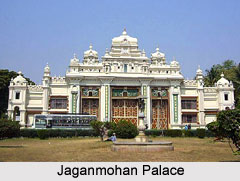 This palace was constructed in the year 1861 by Krishnaraja Wodeyar III in mostly Hindu style to serve as alternate palace for royal family. This palace also housed the royal family when the older Mysore Palace was burnt down by a fire. This palace actually has a three floor and also has stained ventilators and shutters. It has, since 1915, housed the Sri Jayachamarajendra Art Gallery. The collections that are exhibited here include paintings from the famed Travancore ruler, Raja Ravi Varma, the Russian painter Svetoslav Roerich and many paintings of the Mysore painting style. The Durbar Hall here was the place where the early convocations of the Mysore University were held. The hall also serves as an auditorium for staging cultural programmes.
This palace was constructed in the year 1861 by Krishnaraja Wodeyar III in mostly Hindu style to serve as alternate palace for royal family. This palace also housed the royal family when the older Mysore Palace was burnt down by a fire. This palace actually has a three floor and also has stained ventilators and shutters. It has, since 1915, housed the Sri Jayachamarajendra Art Gallery. The collections that are exhibited here include paintings from the famed Travancore ruler, Raja Ravi Varma, the Russian painter Svetoslav Roerich and many paintings of the Mysore painting style. The Durbar Hall here was the place where the early convocations of the Mysore University were held. The hall also serves as an auditorium for staging cultural programmes.
Jayalakshmi Vilas Mansion
This particular palace was constructed in the year 1905 by Chamaraja Wodeyar for Jayalakshmi Devi, his eldest daughter. This museum has three wings and also contains a series of twin Corinthian and Ionic columns, regal pediments and oval ventilators. This mansion was acquired by the University of Mysore to house its post-graduate campus. It was modernized in the year 2002. The main home in the palace is Kalyana Mantapa that has eight petal shaped dome with stained glass windows with a gold-plated Kalasha (tower) at the top.
Lalitha Mahal
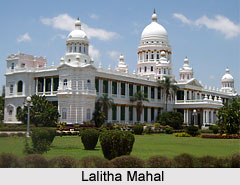 This palace, Lalitha Mahal, was built by Krishnaraja Wodeyar IV in 1921 and main architect was Mr E W Fritchley. The mansion is pure in colour and was also built in the style of Italian palazzo with twin Ionic columns and domes. It also has rambling terrace and landscaped gardens. However, this palace was converted into five star hotels belonging to the Ashok Group of Hotels. The interior of this palace contains venation marble floors, rosewood furniture and a stately balustrade staircase. The central hall in the palace contains life size portraits of the royalty, lithographs, motifs, a Belgian glass dome and carved wood shutters. An ancient elevator, still in working condition is also present.
This palace, Lalitha Mahal, was built by Krishnaraja Wodeyar IV in 1921 and main architect was Mr E W Fritchley. The mansion is pure in colour and was also built in the style of Italian palazzo with twin Ionic columns and domes. It also has rambling terrace and landscaped gardens. However, this palace was converted into five star hotels belonging to the Ashok Group of Hotels. The interior of this palace contains venation marble floors, rosewood furniture and a stately balustrade staircase. The central hall in the palace contains life size portraits of the royalty, lithographs, motifs, a Belgian glass dome and carved wood shutters. An ancient elevator, still in working condition is also present.
Rajendra Vilas
This is a palace atop the Chamundi Hill. This was conceived in the 1920s and completed in 1938-1939. This was built as a summer palace for the Wodeyar kings. This palace is currently owned by the current scion of the royal family, Srikantadatta Narasimharaja Wodeyar. There are plans to convert this into a Heritage hotel.
Cheluvamba Mansion
This particular mansion was constructed by Krishnaraja Wodeyar IV for his third daughter, Cheluvarajammanni. It now houses the CFTRI (Central Food and Technological Research Institute).
Paintings of Mysore
Mysore Painting
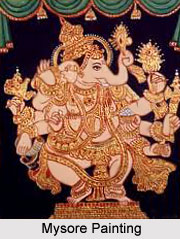 The conventional form of painting is known as Mysore painting and is an offshoot of the Vijayanagar school of Painting. As soon as the Vijayanagar Empire fell, the artists who were fully involved in the Vijayanagar Paintings were left jobless. Raja Wodeyar, Wodeyar King, rehabilitated these artists in Srirangapatna and under his patronage, a novel form of painting known as Mysore painting developed. These artists also employed by the king made full use of the locally available materials to do the paintings.
The conventional form of painting is known as Mysore painting and is an offshoot of the Vijayanagar school of Painting. As soon as the Vijayanagar Empire fell, the artists who were fully involved in the Vijayanagar Paintings were left jobless. Raja Wodeyar, Wodeyar King, rehabilitated these artists in Srirangapatna and under his patronage, a novel form of painting known as Mysore painting developed. These artists also employed by the king made full use of the locally available materials to do the paintings.
The hair of the squirrel was used as a brush by tying the hair with the silken thread and also inserting them into the narrow end of quill. A cloth spread over a wooden plank formed the painting board. Properly burnt tamarind sticks were used as a sketching charcoal. The main attraction of these paintings was the gesso work in which gold foils were pasted on appropriate regions on the painting. Gesso was used for depicting intricate designs of clothes, jewellery and architectural details. Stories from the Ramayana, Mahabharata, Bhagavata Purana and Jain epics formed the basis of these paintings. Mummadi Krishnaraja Wodeyar (Krishnaraja Wodeyar III) was instrumental in the growth of the Mysore painting form and is said to have commissioned more than 1000 portraits during his reign. Many of these paintings can still be seen on the walls of the Jaganmohan Palace at Mysore.
Ganjifa Art
Ganjifa or Ganjeefa was a well-known card game in prehistoric India. This was widely played during the Mughal Period. And now, Ganjifa is known for its art work on the cards than the game itself.
Crafts of Mysore
Crafts of Mysore are very popular across India. The popular crafts of Mysore are Rosewood Inlay work and Mysore silk saree.
Rosewood Inlay Work
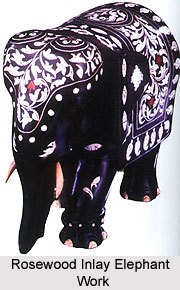 These are intricate designs made on wooden structures. And the work is done in various stages. The very first step of the process is to draw and design the patterns and images on the rosewood. After that the rosewood is cut into proper size and shape by carpentry. The motifs that have to be inlaid are then carefully hand-cut to shape. The areas where the motifs have to be inlaid on the rosewood are carefully scooped out. Next the motifs are inlaid and fixed. The wood is then smoothened using sandpaper and polished to give a bright look.
These are intricate designs made on wooden structures. And the work is done in various stages. The very first step of the process is to draw and design the patterns and images on the rosewood. After that the rosewood is cut into proper size and shape by carpentry. The motifs that have to be inlaid are then carefully hand-cut to shape. The areas where the motifs have to be inlaid on the rosewood are carefully scooped out. Next the motifs are inlaid and fixed. The wood is then smoothened using sandpaper and polished to give a bright look.
Mysore Silk Saree
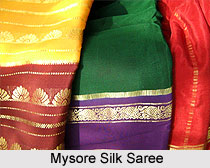 Mysore as a city is a popular for feminine saree. Silk is a trademark in the city, and Karnataka Silk Industries Corporation is a popular manufacturing unit. These saree uses 100% pure gold zari. Mysore silk sarees are also undergoing an innovating change with the use of kasuti embroidery, thickly woven pallus (the part of the saree worn over the shoulder), bandhini techniques and new colours like lilac, coffee-brown and elephant-grey
Mysore as a city is a popular for feminine saree. Silk is a trademark in the city, and Karnataka Silk Industries Corporation is a popular manufacturing unit. These saree uses 100% pure gold zari. Mysore silk sarees are also undergoing an innovating change with the use of kasuti embroidery, thickly woven pallus (the part of the saree worn over the shoulder), bandhini techniques and new colours like lilac, coffee-brown and elephant-grey
Costumes of Mysore
For majority of people in Mysore, the attire resembles those of the rest of Southern part of India. Lungi is popular among men at home where they wear shirts and pants outdoors. Saree and Salwar Kameez are popularly worn by females. For formal occasions like marriage, females mostly prefer to wear a silk saree with gold jewellery. Western attire like jeans, Bermuda shorts and skirts find lot of favour with the younger generation.
Music of Mysore
Mysore Nagaraj and Dr. Mysore Manjunath are globally famous violin maestros from the city of Mysore. Dr. Mysore Manjunath and Mysore Nagaraj are the proud disciples and sons of veteran musician Sangita Vidya Nidhi Vidwan Mahadevappa. The brothers are extremely popular and their outstanding musicianship and astounding virtuosity made them one of the best violin players in the contemporary music world. They symbolize the genre of Carnatic Music and have also worked together with many musicians of world class stature in countless number of nations at important musical festivals and seminars. Dr. Mysore Manjunath also has the recognition of representing India at a variety of top venues, including global violin conference and world music festival held in Chicago. Countless awards and honours have been credited to these wonder musicians.
Festivals of Mysore
Festival of Mysore is celebrated with all the pomp and galore. One of the popular names for Dasara in the state of Karnataka is Nadahabba (state festivals). Often, it is also known as Navaratri (nine nights) and is a 10-day festival with the last day being Vijayadashami, the most auspicious day of Dasara, which generally falls in the month of September and October according to English calendar.
Going little into the history of this festival it can be seen that it was first celebrated by Wodeyar King, Raja Wodeyar I in 1610. The Mysore Palace, during Dasara is lit up for 10 days. The celebrations start with Wodeyar royal couple performing a special puja to Goddess Chamundeshwari in the Chamundi Temple located on the top of Chamundi Hill at Mysore. This would also be followed by royal assembly. Kings wore conventional Mysore Peta as headgear during the time of Durbar (court of Indian or kings of princely states of India) or in a ceremonial procession during the Dassara celebrations.
It was in the year 1805, during reign of Krishnaraja Wodeyar III when the king started the convention of having special durbar in Mysore Palace during Dasara that was attended by members of the royal family, special invitees, officials and the masses. The King and the men attending the court of the King wore the traditional dresses known as Durbar Dress that comprised a black long coat with white trouser and compulsory Mysore Peta. The convention has sustained even now with present scion of Wodeyar family, Srikantadatta Narasimharaja Wodeyar holding a private durbar during Dasara. The ninth day of Dasara is known as Mahanavami and is also spent as auspicious day on which the royal sword is worshipped and is taken on procession involving elephants, horses and camels.
One of the major attractions during the Dasara is the exhibition of Dasara that is held in the exhibition grounds opposite to the Mysore Palace. This exhibition that begins with Dasara goes on till December. On 10th day of Dasara many dance and music concerts are held in auditoriums around Mysore city. Dance groups and musicians from across India are invited to perform on this occasion. Another attraction during Dasara is the Kusti Spardhe (wrestling-bout) which attracts wrestlers from all around India.
Cuisine of Mysore
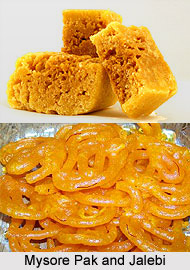 To a great extent the cuisine of Mysore is similar to the Udupi cuisine. Rice is staple food used in cooking and many other spices are also used. For breakfast the food generally include dishes made of rice like idli and dosa. Another popular breakfast item is Vada. Some of the other dishes for breakfast include shavige bath (spicy dish made of vermicelli), rava idli, oggarane avalakki (seasoned beaten rice), Pongal and Poori.
To a great extent the cuisine of Mysore is similar to the Udupi cuisine. Rice is staple food used in cooking and many other spices are also used. For breakfast the food generally include dishes made of rice like idli and dosa. Another popular breakfast item is Vada. Some of the other dishes for breakfast include shavige bath (spicy dish made of vermicelli), rava idli, oggarane avalakki (seasoned beaten rice), Pongal and Poori.
Generally the lunch and dinner includes steamed rice, chutney, sambar, pickle, curry, gojju (a sweet curry), rasam, papad and curds. Some of the popular rice based dishes are Bisi bele bath (a spicy rice preparation with vegetables), Vangi Baath (rice mixed with Brinjal curry), chitranna (rice mixed with seasoning, turmeric and lemon juice or raw mango scrapes) and Puliyogare. Nowadays, Chapati is another lunch item that is preferred by people. In case of formal events like marriages, the food is served on a plantain leaf and in most cases includes items like sweets and Kosambari apart from the ones mentioned above.
Apart from the above mentioned dishes, sweets like rave unde (sweet balls made of semolina and coconut scrapes), ladoo, rice payasam, Mysore Pak and jalebi, also play a crucial role in Mysore cuisine. It is usual to eat adike (arecanut) with betel leaf after the lunch/dinner. At home, coffee is a preferred beverage. Among snacks which are prevalent are chakkuli, khara mandakki (spicy puffed rice), churmuri and kodubale (a doughnut shaped spicy snack made of fried semolina). In the last few years, chaat, pizzas and items belonging to Indian Chinese cuisine have become popular mostly with the younger generation. Mysore has also lent its name to the sweet-dish Mysore Pak and the Mysore Masala Dosa.



















